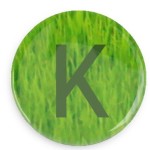Most of us know that this creation is made up of fundamental elements – 118 at the last count. Some we’ve heard of – oxygen, gold, silver – and some most of us haven’t – number 118 is Ununoctium.
Knowledge of this doesn’t help us very much with our day to day care for our bodies. Most of us wouldn’t even know which of these elements we have in our bodies, let alone whether we have the correct balance or not.
From ancient times, a simpler method was used to describe the elements of creation. These are the five fundamental elements; space, air, fire, water and earth.

These elements are all present in differing quantities in various substances. As the human body is seen as a microcosm of the universe, it too is formed of these 5 elements.
Viewing the body and mind through the lenses of these elements, the Ayurvedic sages discovered the unique concept of doshas; three principles which govern our minds and bodies. These doshas have biological and energetic properties and regulate all physiological and psychological aspects of our lives.
These three primary patterns or doshas – vata, pitta and kapha – are present in every cell, tissue and organ of the body. We are all born with a unique and individual combination of these doshas (our constitution), which defines the ways our bodies and minds naturally function and respond. It is important to be aware of our doshas as it is only when they are in their natural balanced state that we remain in health. When they get out of balance, diseases occur. Often an individual will have a primary dosha, and it is most often that dosha which will tend to go out of balance when our lives aren’t as measured as they should be. You can find out your possible constitution with our dosha quiz.

Vata, based on the elements of air and space, regulates movement and change. Pitta, woven from elements of fire and water, governs digestion and metabolism. Kapha, comprised of earth and water, maintains, grounds and nourishes.
Vata predominant constitutions tend to:
- have a nature of change and fluctuation; irregular appetite, thirst and bowel movements, variable energy levels coming in bursts and irregular menstrual cycles.
- be more endowed with movement; active eyes, fast speech, quick bodily movements and always on the go. The mind is also agile, creative, lively and enthusiastic. There is a desire for change and routines are often a struggle. Things are picked up quickly but more often forgotten in the long term.
- have more dryness and roughness in the body; dry, rough skin, lips and hair, cracking joints. They are more likely to be constipated and have wind.
- be more cold; often have cold hands and feet and strongly dislike cold and wind, prefer warm environments, food and drinks.
- be light; in general have a slender body and thin muscles finding it hard to put on weight. Specifically lightness also shows with thinner lips, visible joints and sharper nose. Sleep is also light and sometimes elusive.
Those with a vata constitution will be more likely to suffer from constipation, gas and insomnia when not in balance. The mind when out of balance tends towards anxiety, fearfulness and insecurity.
Pitta predominant people tend to:
- be hot; be warm regardless of season, sweat easily and be fatigued by heat. There will be a preference for cool environments, cool food and drink and there will be quite a lot of thirst.
- have lightness, liquidity and a sense of flow due to the combination of water and fire, thus they have moderate build and energy; by putting their mind to it, they’ll be able to gain or lose weight as they choose. Energy is naturally moderate, movements are of moderate speed and sleep is moderately sound (less than 8 hours leaves them rested).
- have fire in their bellies; strong appetites and strong digestion of food, information and experience. If they go long without food, they’ll suffer and get irritable. Their strong digestive fire makes for easy, regular, looser bowel movements.
- have more red or yellowish tones; skin, hair, lips and teeth . Their hair will more likely be fine and prone to early greying or balding. The warmer, reddish skin will be prone to irritation and burns easily.
- have a certain mental intensity; focused, driven, goal-oriented and naturally alert, intelligent and persevering. The eyes will have a penetrating gaze and their speech is equally penetrating and clear. They will love to convince, like structure and detail and are often organised. Decision making comes easily. Compete with and criticise them at your peril!
- have a degree of oiliness (versus the dry, roughness of vata for example); lips are red and soft, skin is relatively soft and joints are flexible.
- more likely to have an odour (one of their least flattering characteristics!)
Those with more pitta dosha in them will tend towards inflammation, hypertension and hypersensitivity if they are out of balance. Mentally they could end up being more angry, aggressive or argumentative.
Those with Kapha predominance are most likely to:
- be solid, heavy and firm. These might not sound like attractive qualities but actually, they make for very healthy bodies and minds. Build will be naturally larger and round, with a broad frame and large, well-knit, padded joints. They gain weight easily and find it hard to shift. Their eyes are large and pleasant, lips, nose and teeth are also large. Sleep is heavy, 8 hours is often needed, and often they will oversleep and have difficultly waking.
- have the quality of thickness in their tissues; thick, moist skin and abundant and thick hair.
- be smooth and have higher levels of oiliness; skin and hair is smooth and oily, eyes are well lubricated as are the joints. This also equates to a lower thirst.
- be earthy and deliberate or slow; solid, reliable, contented souls who tend to be grounded. Speech and movements are slow and deliberate. Their energy levels are steady and they tend to have good endurance and stamina. The slow quality is also seen in the digestion and bowel movements. Mentally this quality shows a natural resilience in the face of stress making for a calm person who is loyal and patient with an inner sense of stability and contentment. Sometimes it takes a while to grasp new things but once they are remembered, they stick, as do decisions.
- have colder bodies; adaptable to most temperatures but tend not to like cold, wet weather; prefer hot, dry weather.
Kapha dominant people will tend to have excess mucus, congestion and water retention if they aren’t in balance. When they are not on good form, they can tend towards lethargy and withdrawal.
The beauty of this knowledge, is that once you get a gauge on what doshas are strongest in your constitution and which tend to go out of balance, you can look after yourself in such a way that these doshas don’t get the upper hand. More on this in future blog-posts!
Have fun ruminating on your doshas, those of your friends, partners and children… If you need a hand working it out, here is our handy dosha quiz.
Till next time, take care of yourselves.
Kate
Author: Kate Siraj, Ayurvedic Practitioner, BSc Ayurveda, MChem (Oxon), MAPA.
© The Ayurveda Practice
Photo thanks to FreeDigitalPhotos.net






26 Comments
being divine · July 26, 2016 at 09:53
Nice One
From SAD to happy with Ayurveda | Living Ayurveda · March 3, 2014 at 13:50
[…] and space), pitta (principles of fire and water) or kapha (principles of earth and water) – see the previous blog post on doshas for more on these. The cause of S.A.D. is lack of sunlight and this lack of ‘fire’ element […]
Caffeine – gets us moving, at what cost? | Living Ayurveda · June 18, 2014 at 13:30
[…] increases movement in the mind and body and thus increases the vata dosha. Ongoing use of caffeine can leave us with a vata imbalance which can mean symptoms such […]
Watch the wind – it’s a tricky little fellar | Living Ayurveda · September 10, 2014 at 13:18
[…] vata, the ‘wind’ (or air and space) principle in your body and mind. It is one of the three doshas (vata, pitta and kapha) which are present in every cell, tissue and organ of the body and regulate all physiological and […]
Watch the wind - it’s a tricky little fellow - Living Ayurveda · October 1, 2014 at 11:35
[…] vata, the ‘wind’ (or air and space) principle in your body and mind. It is one of the three doshas (vata, pitta and kapha) which are present in every cell, tissue and organ of the body and regulate all physiological and […]
Caffeine – gets us moving, at what cost? - Living Ayurveda · October 1, 2014 at 11:39
[…] increases movement in the mind and body and thus increases the vata dosha. Ongoing use of caffeine can leave us with a vata imbalance which can mean symptoms such […]
From SAD to happy with Ayurveda - Living Ayurveda · October 1, 2014 at 12:02
[…] and space), pitta (principles of fire and water) or kapha (principles of earth and water) – see the previous blog post on doshas for more on these. The cause of S.A.D. is lack of sunlight and this lack of ‘fire’ element […]
Packed lunches: Can they be healthy, easy, cheap, environmentally and child-friendly? - The Ayurveda Practice · October 15, 2014 at 13:48
[…] I can provide, knowing that despite being cold and possibly a little drying (not good for vata, especially in the autumn and winter months), they are full of good […]
Know your proteins – they literally build you - · April 29, 2015 at 10:38
[…] If you don’t know which dosha you are predominant in, please have a look at the descriptions here. […]
Practical Living Tips From Āyurveda Specialist Kate Siraj | Zen Monkey, your yoga alternative to wheatgrass · October 10, 2015 at 03:02
[…] The doshas are the mainstay of Āyurveda and are used on a daily basis as a diagnostic tool to work out our […]
Good sleep, great health - · October 16, 2015 at 16:29
[…] categorises sleep disorders into types according to the predominant dosha (physico-psychological […]
Tune into daily rhythms for best health - The Ayurveda Practice · December 1, 2015 at 11:02
[…] day by looking at how the particular energetic and physical qualities of a time of day affect the doshas(the interplay of elements in the […]
Smoothies and juices – choose wisely - The Ayurveda Practice · March 15, 2016 at 14:31
[…] yourself. If you have poor digestion or have a vata constitution, do not have many smoothies. If you digest food well, without any bloating, diarrhoea […]
Panchakarma – powerful therapy, intense results - The Ayurveda Practice · September 9, 2016 at 13:41
[…] gout, high blood pressure[4] and liver diseases. It is very useful for any disease caused by high pitta and is recommended on an annual basis in the autumn (after the heat of summer) to prevent the […]
Enjoy your Christmas roast with impunity this winter - The Ayurveda Practice · December 15, 2016 at 12:05
[…] heavier, oilier foods which ground us and keep us warm. The season of autumn and winter are high-vata seasons. This means we can feel dried out, cold and possibly airy and ungrounded (although many of […]
Banish sugar cravings - The Ayurveda Practice · March 17, 2017 at 14:00
[…] Ayurvedic view on refined sugar is also not favourable. It upsets all three doshas (vata, pitta and kapha) and can cause the formation of […]
Add spices, add flavour, improve nutrition - The Ayurveda Practice · October 13, 2017 at 12:18
[…] Herbs and spices have different tastes, heating or cooling qualities and effects on the body. Most will aid digestion. For best results, use ones which most suit your constitution or state of health. In Ayurveda these are viewed in terms of doshas. […]
Women, love your cycle (and men, it REALLY helps to know) - The Ayurveda Practice · May 3, 2019 at 15:20
[…] diagram below shows the phases of the cycle, showing which doshas are predominant, what the hormones are doing and what is happening in the uterus during these […]
Understanding your elemental constitution and imbalance – in pictures - The Ayurveda Practice · May 3, 2019 at 16:28
[…] For example, someone who has mostly air and space elements in their body and mind will have a vata constitution which can be represented like this and would have characteristics of changeability, dryness, lightness and coldness (read more on vata here). […]
Conquer stress with my five favourite adaptogens - The Ayurveda Practice · May 3, 2019 at 16:29
[…] Doshas: Decreases vata and kapha, increases pitta (explanation of doshas) […]
To travel is to live – but don’t let it cost your health - The Ayurveda Practice · June 21, 2019 at 15:15
[…] as something to watch out for. All the principle texts of Ayurveda list travel as one of the vata-increasing factors. These texts were written in the days of horses and carts; imagine what […]
Use your clever early warning system - The Ayurveda Practice · November 24, 2021 at 14:53
[…] the bud, self-correcting back to a balanced state. Prevention is even better; understanding your constitution and thus the things that help and hinder you can stop disease before stage 1 even kicks […]
Your guide to dosha imbalance - The Ayurveda Practice · May 6, 2022 at 11:05
[…] dosha has its qualities so the simplest way to gauge a dosha imbalance is to see which of these qualities […]
Menopause – important life transition not an illness - The Ayurveda Practice · October 6, 2022 at 15:14
[…] stages of our lives are deeply influenced by each of the three dosha. The peri-menopause is roughly the end of the pitta time of life, a period of activity and […]
Hay fever be gone - The Ayurveda Practice · May 10, 2023 at 14:37
[…] dosha can be responsible for hay fever. If one (or more) of your doshas are out of balance, hay […]
Fasting - what does Ayurveda say? - The Ayurveda Practice · February 2, 2024 at 12:14
[…] when the body gets too heavy, too congested, has too much of the earth or water elements (e.g. kapha or sometimes pitta dosha) or has low digestive fire and āma (the sticky toxins lurking in the body […]